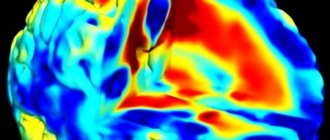.
Obsessive-compulsive disorder (OCD) is a neuroses. Always has a starting point (cause) that led to disruption of the central nervous system. It manifests itself as anxiety, obsessive ideas that force a person to perform certain actions repeatedly, not paying attention to the fact that he is going beyond normal behavior.
Neurosis and schizophrenia
OCD and schizophrenia are not the same thing, but two completely different diseases. Neurosis begins with an acute, traumatic process for the psyche:
- physical, emotional exhaustion;
- loss of a loved one or pet;
- childhood fears;
- a serious illness that makes you rethink reality;
- constant stress.
Obsession is combined with phobic disorders and certain actions that are repeated regularly. This type of deviation is divided into 2 types.
- Relatively safe.
- Leading to irrational fear, causing severe anxiety.
The first includes deviations characterized by a relatively calm course that does not cause harm to patients. The desire to talk about your memories to everyone.
The second is characterized by constant self-analysis, which often leads to attempts to withdraw from society and abandon a certain type of activity.
In schizophrenia, it is impossible to determine the cause. This disease is transmitted genetically and has a chronic course.
It can occur continuously or appear in paroxysms, followed by remission. The above-described provoking factors of OCD cannot be the cause of schizophrenia, but only aggravate its course. Accordingly, neurosis cannot develop into schizophrenia, but can be an accompanying symptom.
Main differences
Schizophrenia is very different from OCD. Neurotics retain common sense and are able to critically evaluate their actions and condition. They are aware that such a condition is not the norm, and they try to actively solve the problem on their own or by contacting a specialist.
The main difference between schizophrenia and OCD is the inability of patients to indicate their location, time, and self.
In patients, all mental functions are split. Even after emerging from a state of psychosis, the patient remains uncritical, behaves strangely, and his statements cause bewilderment among others. Schizophrenics are burdened by an incomprehensible condition, but they do not rush to see a doctor, but try to hide their problem, not only from others, but also from themselves.
The difference between OCD and schizophrenia lies in the state of patients at the time of the appearance of hallucinations. They occur in many disorders. Thus, a neurotic sees a short-term phenomenon in which there is a meaning that connects the pathological state with the starting point: dark circles, melodies, visual images. Hallucinations appear more often before sleep, when the brain is practically turned off, and at the moment of awakening, while brain activity is still weak.
In schizophrenics, hallucinations are violent.
They hear voices that often criticize the behavior of those around them or those around them and try to persuade them to take certain actions or rituals. This process instills fear in the patient, he tries to hide. Patients are sure that these voices are messages from above. Delusions occur in schizophrenic disorders. Abnormal ideas transport a schizophrenic to a completely different reality, replacing real concepts. If the patient begins to be dissuaded in his views, he reacts aggressively and refuses to communicate.
Treatment of neurosis-like schizophrenia
The main goal of therapy is to stabilize the patient’s condition, slow the progression of the disease, and achieve long-term remission. Features of treatment depend on age.
The child must constantly undergo psychotherapy. You need to carefully monitor a number of signs. Sometimes medications are prescribed: nootropic and antipsychotic drugs. The doctor selects medications individually, taking into account the age and individual characteristics of the patient.
In adults, drug therapy is used. It often causes deterioration of the condition and the appearance of side effects.
Antipsychotic drugs and neuroleptics can be used. If the disease is severe and medications are ineffective, electroshock therapy is prescribed: electrical impulses are passed through the brain. The technique may cause temporary memory loss.
An additional measure is psychotherapy. Often carried out together with the patient's relatives. The method helps improve contacts with others, restore normal communication, understand your feelings and emotions, and reduce anxiety.
If there are concomitant disorders, patients with schizophrenia must additionally undergo treatment for other diseases.
Neurosis in schizophrenia
In the ICD-10 classification, this condition is reflected as pseudoneurotic schizophrenia (not to be confused with real schizophrenia). This condition can last 10-30 years without causing much discomfort to the patient. A person suffers more from neurosis and unreasonable fear. The personality defect does not progress; there are no hallucinations or delusions.
The main symptoms of OCD in schizophrenia:
- strange behavior;
- emotional instability;
- desire to explore areas of philosophy, teachings related to the occult sciences, theories of abstractionism;
- reluctance to take care of one’s appearance, complete apathy in this regard; decreased productivity, reluctance to work;
- unreasonable fears;
- the emergence of ideas that become extremely important in the individual’s perception. Patients feel that their aspirations are underestimated.
An individual usually maintains connections with society. His work does not satisfy him, he tries to find a place where he can avoid problems and earn money without putting in much effort. Patients of this type very rarely start families, because they have problems communicating with the opposite sex or have too high demands. Existing fears progress, reaching the point of absurdity.
Is mentism a sign of schizophrenia?
A clear cause of the disorder has not yet been established.
But factors that can provoke its occurrence have been recorded. These include childhood psychological trauma. For example, a teenager who was given a similar diagnosis had parents in constant conflict during his childhood. As the boy himself noted, if they did not quarrel with each other, then they were in conflict with him. The family lived in a one-room apartment, so there was nowhere to hide from this. But the child constantly wanted silence.
Other factors predisposing to the disorder include:
- nervous tension;
- overwork;
- long-term conflicts in the family or at work;
- pathologies of fetal development during pregnancy;
- drug abuse.
The main symptom that accompanies neurosis-like schizophrenia throughout its entire course and distinguishes it from other forms of this disease is phobia. Sometimes they are unfounded and pretentious in nature, which is why they differ from fears in neurosis. For example, the fear that things might get scary. Or fear of putting on glasses, as this will provoke a transition to another reality. The fear that if you count to 10, you will soon die.
Common phobias include fear of open spaces, getting sick, getting dirty, social phobia, fear of being in a dangerous situation and not getting help.
Phobias grow deeply into the patient’s life, and he gradually loses control over himself and criticism of his behavior. Over time, a person stops reacting emotionally to them and talks about them without a horrifying connotation.
Instead of phobias, obsessive actions and rituals come to the fore. The patient may roll over his left shoulder 3 times, chew his fingers, or go to bed wearing a hat and one sock. Ritual actions are overly intrusive. And a person can even force others to do them. For example, a teenager forced his mother to touch the leg of a chair before he sat on it.
Obsessive actions can be the most unpredictable. So, among the patients there are also shopaholics. This is also a kind of obsessive desire, which manifests itself in uncontrolled purchases in unlimited quantities. But schizophrenic shopaholics do not lament the fact that they bought too much or do not have enough finances: they are satisfied with everything.
Unlike neuroses, when a person tries to hide his obsessions and compulsions and seek help as soon as possible, this does not happen with pseudoneurotic schizophrenia. The patient, on the contrary, without being embarrassed by those around him, performs his rituals as many times as he needs, demonstratively and without embarrassment.
Obsessive thoughts are associated with fruitless philosophizing or metaphysical intoxication. These are useless thoughts about the issues of the universe. A person becomes fixated on his unrealistic, overvalued idea, and no one is able to convince him. Hearing criticism addressed to himself, he only strengthens the opinion of his uniqueness.
For the sake of their valuable ideas, such people give up work and stop communicating with friends. They are constantly looking for some information and writing it down. But if you ask them about their idea, you don’t get a clear answer.
Other obsessions are associated with uncontrollable thoughts that bring the patient both satisfaction and horror.
One teenager constantly imagined himself being crushed by a car, his body smeared on the road, his insides turning outward. And this gave him unimaginable pleasure.
In another case, such thoughts drive their owners to suicidal attempts, driving them into despair.
Some pretentiousness and mannerism appear in the behavior of patients with pseudoneurotic schizophrenia. This is more common among women. Their makeup becomes bright and unnatural, and their clothes become ridiculous, flashy and inappropriate. The patient can wear shorts in the summer and complement the ensemble with a fur coat.
Schisis is a splitting of the emotional-volitional, logical and mental spheres. It is this word that is the origin of the word “schizophrenia” already known to us. Psychiatrist Bleuler, who came up with such terminology, interestingly, believed that all manifestations of mental disorders (depression, mania, hallucinations, etc.)
) is schizophrenia in its pure form, and the fact that this condition was divided into separate diseases is the work of other doctors who identified each symptom as a separate pathology. Schisis is crumpled speech, interruption of speech, disruption of the thought process and a feeling of depersonalization (alienation from one’s own body, a person looks at himself as if from the outside). Often, as an example of what schism is, they cite the playing of an orchestra that does not have a conductor.
In schizophrenia, the phenomenon of sperrung is also observed. This is a sharp interruption of a sentence mid-sentence, although there was no irritating factor from the outside. The man freezes in place, forgetting what he wanted to say. Unlike ordinary physical and mental fatigue after a hard day at work, shperrung in patients with schizophrenia is, in a way, “an attempt by higher powers to intervene in his consciousness.”
This is what is called the paroxysmal-progressive type of disorder. It received its second name based on the origin of the word. Translated from English, “shub” is a shift. That is, a fur coat is an exacerbation of a disorder followed by remission. Each new attack causes progression, that is, a worsening of the schizophrenic defect.
The onset of the disease can be traced at a young age, most often in adolescence. The attack is preceded by a change in personality structure according to the type of schizoid psychopathy. Patients develop fears, mood swings, and emotional disturbances. But these changes are not very indicative, since they may occur during age-related crises, and they, as is known, are accompanied by a sharp change in feelings and emotions.
Sometimes the stage preceding the flowering of the disease passes quite smoothly, without personality disorders. And then the disorder appears suddenly, already in the form of an attack.
The paroxysmal period has a rich clinical picture. Its form depends on the predominant syndrome.
The depressive form is manifested by dysthymia, that is, mood disorder, hypochondriacal preoccupation. As with any depressive mood, physical activity decreases and mental activity becomes difficult. A feeling of melancholy is not typical for this form. There is such a condition as resonating depression - fruitless reasoning of a gloomy nature.
Phobias and obsessions are born from depression. They are bright, distinct, annoying, but are not supported by ritual actions.
In contrast to depressive, manic fur-like schizophrenia develops. It is accompanied by motor excitement, and mental soaring is not characteristic of it.
Their hobbies include useless, ostentatious objects. Often such children abuse alcohol and drugs. But what is surprising is that withdrawal and personality degradation are very rare.
As the patient gets older, these signs may subside, and the person even adapts to life in society.
An attack with severe depersonalization is accompanied by a change in self-perception against the background of depressive disorders. Such patients are overly reasonable, sensual, and receptive. Since patients perceive their “I” in a distorted understanding, the world around them changes its hypostasis, not corresponding to reality. As a result, a person withdraws into himself and withdraws from others.
Fur coats with productive symptoms are primarily represented by paranoid ideas. Among them are delusions of persecution, jealousy, poisoning, and relationships. Their emotional background ranges from depressive to stormy and explosive. Such attacks occur more often in men.
A young man of 20 years old, studying at the institute and living in a dormitory, periodically smoked marijuana. One day he was overtaken by a strong fear that there was a monster sitting behind the wall that could kill him. I was afraid to go and see why I was laughed at.
From that moment on, he became suspicious and avoided his comrades. I was afraid that the smoke from the smoked weed would repeat the previous episode. Because of this, I stopped going to college. Stopped sleeping. He claimed that his neighbors smoke marijuana on purpose so that the smoke gets into his apartment and drives him crazy. So they allegedly take revenge on him for playing loud music. I looked into their windows to confirm my assumptions.
Mental automatisms arise when the patient thinks that someone is directing his actions and thoughts. Then hallucinations and pseudohallucinations are added.
The most severe form of fur coat-like schizophrenia is catatonic-hebephrenic. It is the longest, malignant, and most importantly, difficult to predict: it is difficult to predict what the outcome will be. It can also be complicated by delusions and hallucinations, which further complicates its course.
Depersonalization and OCD
Depersonalization is considered a separate disease, but it can accompany some mental disorders. It has been proven that this condition can occur in any person at different points in the life cycle.
Depersonalization in OCD is defensive in nature. The body tries to adapt to certain life difficulties, the brain tries to distance itself from painful memories. The patient is fully aware of the delusional state, but cannot cope with it, perceiving himself completely differently. There is a strong desire to free yourself from obsessive thoughts and feel relief.
Schizophrenics take depersonalization for granted, losing their own “I”, turning into a completely different personality.
Reasons that provoke the appearance of depersonalization syndrome:
- severe shock;
- long-term sluggish clinical depression;
- trauma leading to a change in psychological status;
- schizophrenia, OCD, manic syndrome, autism;
- drug addiction, alcoholism.
In neurotics, depersonalization often becomes a consequence of self-examination, when patients begin to think about what they have achieved in their years, try to recall events that they cannot correct, and reproach themselves for this. In schizophrenia, depersonalization can lead to a state close to coma.
The problem does not require special treatment for neurotics. Usually of a short-term nature. It manifests itself as loss, inability to sensibly assess the situation, and fear of going crazy. Patients do not feel hungry and may refuse to relieve their natural needs. because they feel as if they are in someone else’s body.
Diagnostics
Diagnostics will help determine whether a patient has OCD or schizophrenia.
With compulsive disorder, patients suffer from depression, weakness, and may fall into depersonalization, but personal qualities and individuality are preserved. Neurosis is reversible. A course of psychotherapy returns patients to a normal state. They are able to cope well with conflict situations, without going to extremes, and not paying attention to the difficulties that arise in the process of work or relationships with the opposite sex. OCD cannot turn into schizophrenia. These are two different disorders. The first refers to psychological, the second to psychiatric, is chronic.
A schizophrenic is a ticking time bomb. Apatoabulic syndrome increases over time. A personality defect appears. Emotional aspects of life become inaccessible. Voices appear, indicating what to do, how. One's own personality is lost, the individual becomes uninitiative. Painful fantasies touch the most hidden corners of the soul, upsetting the balance between awareness of reality and fiction. Schizophrenics do not realize that they are sick. Attempts to hint at this cause a wave of aggression, patients pull away. Often the state of apathy progresses into a phase when the individual becomes helpless, unable to take care of himself. A test for neurosis helps to establish an accurate diagnosis.
Symptoms of neurosis-like schizophrenia
With this form of the disorder, there are no delusions or hallucinations. Patients do not experience voices in the head, persecutory delusions, or other common symptoms associated with other varieties. For this reason, the disorder is considered an atypical form. The ability to experience strong emotions gradually decreases.
A sign of neurosis-like schizophrenia is decreased motivation, willpower, and increased fatigue.
Since neurotic manifestations are highly developed, only an experienced psychiatrist can make a diagnosis. Strong fears, phobias, obsessive states, movements, and actions arise. The patient is prone to performing rituals. There may be excessive preoccupation with external condition or health, confidence in the presence of physical deformity or dangerous diseases.
The first signs can appear in childhood, manifesting themselves in the form of fears. Persistent changes, however, appear only at the age of 18-20.
Most often, phobias are constant, new ones are added infrequently. The symptoms gradually intensify, the fear becomes stronger. Thinking is not disrupted.
The patient’s condition allows him to care for himself and work independently; Realization of creative potential and career growth is possible. A person can live a full life, get married, raise children, communicate with other people, if therapy is started in a timely manner.
Therapy
Treatment for OCD comes down to psychotherapy. During classes with patients, prevention of social maladjustment is carried out. The main goal of the sessions is to determine the starting point. By eliminating the cause, patients can return to normal life. Relief of symptoms is carried out only in selected cases. Mild sedatives may be prescribed; for severe psychosis, antidepressants are used. After treatment, patients are advised to avoid severe shocks and visit a doctor at least once a year.
Schizophrenia is treated with medications. The drugs can be prescribed for life.
Psychotherapy is appropriate only for patients who maintain common sense and have a combination of OCD and schizophrenia.











